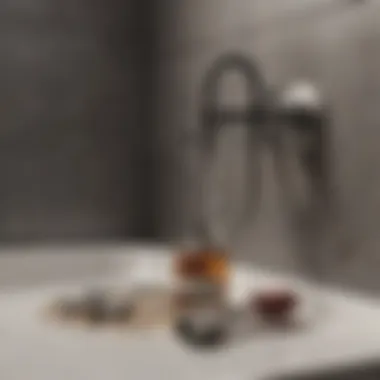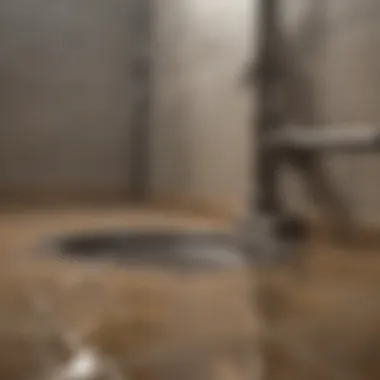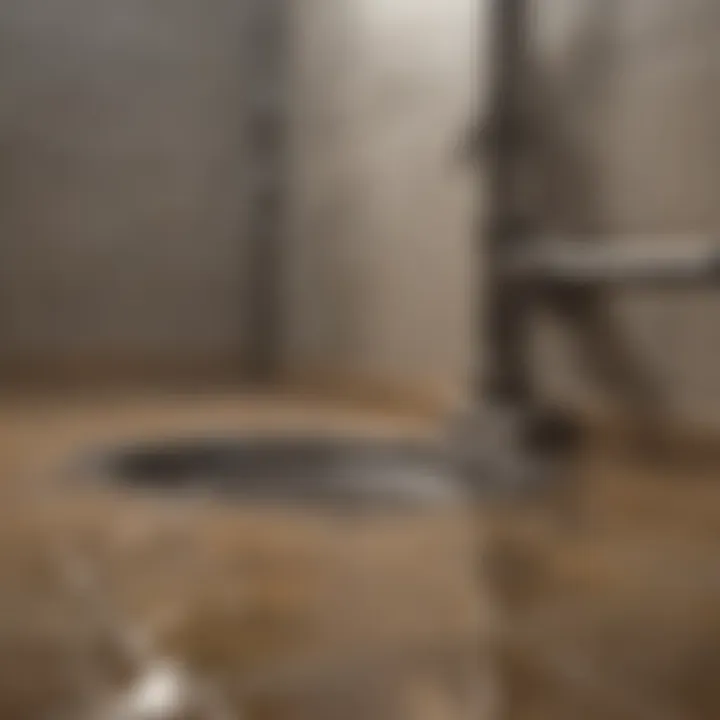Mastering Shower Drain Cleaning: A Step-by-Step Guide


Intro
Cleaning the shower drain is often an afterthought for many homeowners. Yet, it holds significant importance in maintaining a hygienic bathing environment. A blocked or dirty drain can lead to unpleasant odors and potential water damage. Therefore, understanding how to effectively clean the shower drain can save you time, effort, and money in the long run. This guide aims to provide a comprehensive overview of techniques, tools, and preventive measures.
Understanding the Importance of Drain Cleaning
Shower drains are subject to constant use. Hair, soap residue, and other debris can accumulate quickly. Clogged drains can affect water flow and lead to larger plumbing issues.
"Regular maintenance of your shower drain not only prevents blockages but extend the lifespan of your plumbing system."
By prioritizing this task, homeowners can enjoy a more pleasant shower experience while avoiding costly repairs.
Tools Required for Drain Cleaning
Having the right tools makes the cleaning process more efficient. Here are some essential tools for shower drain maintenance:
- Rubber gloves: To protect your hands from debris and cleaning solutions.
- Drain auger: Useful for breaking up and removing stubborn clogs.
- Plumber’s snake: A flexible tool designed to reach deep into pipes.
- Bucket: To collect water and debris as you clean.
- Old toothbrush: For scrubbing smaller parts of the drain.
- Sink strainer: To catch hair and other particles in the future.
These tools can simplify the cleaning process tremendously.
Step-by-Step Cleaning Process
- Remove any visible debris: Start by pulling out hair and residue. This may require the use of rubber gloves.
- Use a bucket: Place it under the drain to catch any excess water.
- Clear out the trap: If your shower has a trap, remove it and clean it thoroughly.
- Employ a drain auger or plumber's snake: Insert the tool into the drain to tackle clogs further down the line. Turn it to break apart blockages.
- Scrub the area: Use the old toothbrush to clean around the drain and ensure all residue is removed.
- Rinse thoroughly: Pour hot water down the drain to flush out remaining debris and cleaning solutions.
Following this sequence can ensure an efficient cleaning process.
Preventative Measures
To minimize the chance of future blockages, consider the following preventive strategies:
- Install a drain cover: This will capture hair and larger debris before it enters the drain.
- Regular cleaning: Make it a habit to clean the drain at least once a month.
- Avoid pouring fats or oils down the drain: These can solidify and cause clogs.
Implementing these strategies can significantly reduce the frequency of necessary deep cleaning.
Finale
Maintaining a clean shower drain is essential for a hygienic and functional bathroom. By understanding the importance of regular cleaning, employing effective techniques, and taking preventative measures, homeowners can enjoy a free-flowing and odor-free shower experience. Arm yourself with the right tools and knowledge to ensure your drainage system remains healthy.
Understanding Shower Drain Maintenance
Shower drain maintenance is an essential yet often ignored aspect of home care. The drainage system in your bathroom plays a crucial role in ensuring good hygiene and functionality. Regular attention to your shower drain can enhance water flow and prevent unpleasant odors. Maintaining clean drains can also help in avoiding costly repairs and extensive renovations down the line.
Importance of Regular Drain Cleaning
Regular cleaning of the shower drain is pivotal for several reasons. First, clean drains minimize the risk of clogs. Over time, hair, soap scum, and other debris can build up and cause blockages. By proactively cleaning the drain, you can reduce the frequency of these clogs, which may otherwise necessitate intervention with costly plumbing services.
Second, clean drains contribute to a more hygienic environment. Bacteria and mold thrive in damp, dirty spaces. Regular maintenance reduces these risks, ensuring that your bathing area remains safe and pleasant. Moreover, this practice can help in preserving the overall condition of your bathroom surfaces.
Consequences of Neglected Drain Maintenance
Neglecting shower drain maintenance can result in significant consequences. First, the most obvious issue arises when water fails to drain properly, leading to standing water in the shower area. This stagnant water can invite unpleasant smells and create ideal breeding conditions for mold and fungi.
Additionally, clogs can lead to more severe plumbing issues. If not addressed, you may experience backflow or leaks that can damage your bathroom's infrastructure and lead to expensive repairs. Furthermore, frequent plumbing interventions can disrupt your routine and lead to inconvenience.
"Ignoring shower drain maintenance may lead to costly plumbing bills and a less hygienic living space."


In summary, understanding and implementing regular drain maintenance is crucial. It ensures that your shower functions optimally, keeps hygiene levels high, and helps you avoid unnecessary plumbing expenses. Using adequate approaches will surely enhance the quality of your home environment.
Common Causes of Drain Clogs
Understanding the common causes of drain clogs is crucial for maintaining a clean and functional shower. Identifying these factors not only helps in resolving current issues but also plays a significant role in preventing future problems. This section will delve into three predominant offenders: hair accumulation, soap residue build-up, and mineral deposits from hard water. Each plays a vital role in contributing to drainage blockages and knowing how they operate can help homeowners maintain a healthier and more efficient drainage system.
Hair Accumulation
One of the leading causes of clogged drains in showers is hair accumulation. Hair can easily wash down the drain during showers but can create a substantial blockage over time. This is particularly true in households where multiple individuals use the same shower regularly. When hair strands combine with soap scum and other debris, they can create complex clogs that are challenging to remove.
To alleviate this, it is advisable to use a drain cover or strainer that catches hair before it enters the plumbing system. Regularly removing hair from the shower floor and drain cover can significantly reduce the likelihood of build-up.
Soap Residue Build-up
Soap residue is another common contributor to clogged drains. When soap dissolves in water, it can leave behind a greasy film that sticks to the pipes. Over time, this build-up can combine with other debris, including hair, leading to serious clogs.
Different soaps may vary in their ingredients, which can affect how they interact with water and contribute to residue build-up. It may be beneficial to switch to natural soaps or those specifically designed to minimize residue. Additionally, regularly cleaning the shower surface can prevent the accumulation of soap scum and debris.
Mineral Deposits from Hard Water
Hard water contains high levels of minerals, such as calcium and magnesium, which can accumulate within plumbing fixtures. Over time, these mineral deposits can harden and restrict the flow of water through the drain leading to clogs. This condition can be exacerbated if the shower is rarely cleaned.
Using water softeners or regularly cleaning with vinegar can help mitigate this issue. Vinegar acts as a natural cleaner that can dissolve mineral build-up. Homeowners should be vigilant about maintaining their shower fixtures, as consistent care can prolong the life of plumbing systems and reduce the frequency of clogs.
"Identifying the common causes of drain clogs is the first step towards effectively cleaning and maintaining your shower drain. Regular awareness can lead to preventive care measures that save time and effort in the long run."
Tools and Materials Needed
Cleaning your shower drain can require various tools and materials. Understanding what you need is key to an efficient process. Having the right cleaning tools and materials not only speeds up the task but also ensures that it is done effectively. With the right equipment, you can dislodge clogs, maintain cleanliness, and promote a healthy household environment. Furthermore, choosing between chemical cleaners or natural remedies adds another layer of consideration regarding safety, effectiveness, and environmental impact. Ensuring you also have protective gear is vital for personal safety during this task.
Basic Cleaning Tools
When tackling shower drain cleaning, a few basic tools will make the job easier. Here are several essential items:
- Plunger: This tool can help in loosening stubborn clogs. The pressure created can dislodge hair or soap buildup easily.
- Drain Snake: A drain snake is useful for reaching deeper clogs. This flexible tool allows you to navigate bends in the pipes and pull out debris.
- Bucket: A bucket catches any water that may spill during the cleaning process, which minimizes mess.
- Screwdriver: This is needed to remove the drain cover, allowing direct access to the drain.
- Brush: A stiff-bristled brush can scrub away any residue inside the drain.
By having these tools ready, you can efficiently perform the cleaning task and avoid interruptions.
Chemical Cleaners vs. Natural Remedies
Choosing between chemical cleaners and natural remedies is an important part of maintaining your shower drain. Chemical cleaners, such as Drano, contain specific agents designed to break down clogs quickly. However, they can also pose risks to both the environment and personal health. Proper ventilation is a must when using these products. Always follow the instructions carefully to prevent accidents.
On the other hand, natural remedies like baking soda and vinegar provide an eco-friendly alternative. These substances work well for minor clogs and frequent maintenance. For example:
- Baking Soda and Vinegar: Pour half a cup of baking soda down the drain followed by half a cup of vinegar. Wait for 30 minutes and then flush with hot water.
- Salt and Baking Soda: A mixture of these can help in combating grease.
Natural options tend to be safer but may not be as immediate or effective for severe clogs. Understanding the severity of the issue will guide your choice of cleaning method.
Protective Gear Considerations
Ensuring safety while cleaning your shower drain is paramount. Certain protective gear can help minimize potential hazards:
- Gloves: Wear rubber gloves to protect your hands from chemical burns or sharp objects such as broken glass.
- Goggles: Eye protection is important, especially if using chemical cleaners. These products can splash and cause irritation.
- Masks: If using chemical vapors, a mask can protect against inhaling harmful substances.
These items may seem like an additional hassle, but they are essential in ensuring you can complete the task safely without injury.


In summary, understanding the tools and materials needed for cleaning your shower drain significantly impacts your effectiveness. Whether using basic cleaning tools, choosing chemical or natural cleaning solutions, or donning appropriate protective gear, these elements contribute to a successful cleaning process.
Step-by-Step Guide to Cleaning Shower Drains
Cleaning shower drains effectively requires a systematic approach. This section outlines the critical steps to ensure efficient and thorough cleanings, from preparation to testing functionality. It is vital for anyone who wishes to maintain clean and functional drainage systems. Proper cleaning reduces unpleasant smells, promotes hygiene, and prevents more severe plumbing issues down the line. Moreover, having clear steps increases the success rate of these cleaning efforts, making it easier for homeowners to undertake tasks themselves.
Preparing the Area
Clearing the Shower Space
Clearing the shower space is paramount before starting any cleaning process. This not only provides easy access to the drain but also ensures a safe working environment. A clean area minimizes the chances of accidents, such as slipping on wet surfaces or knocking over cleaning supplies. Additionally, it allows for a more thorough inspection of the drain area. Removing any items like shampoos or soap dishes is highly recommended. Doing so creates a clear pathway to the drain, which enhances the overall efficiency of the cleaning task.
Gathering Necessary Tools
Gathering necessary tools is essential for a successful cleaning session. Proper tools will not only make the task easier but also more effective. Common tools include a drain snake, gloves, a bucket, and cleaning solutions. Having everything on hand before starting saves time and frustration during the process. It ensures that the homeowner can respond quickly to any obstacles encountered, such as a stubborn clog. Understanding what tools are best suited for the task can significantly improve the outcomes of the cleaning efforts.
Removing the Drain Cover
Removing the drain cover is a straightforward yet crucial step in the cleaning process. It often involves unscrewing or lifting the cap, depending on your specific shower model. This act exposes the drain directly for cleaning and inspection. Ensuring that the cover is carefully removed prevents any potential damage to the cover, which might lead to further issues later on.
Dislodging Clogs
Using a Drain Snake
Using a drain snake is an effective technique to dislodge stubborn clogs. It involves inserting the snake into the drain and maneuvering it to break apart blockages caused by hair, soap residue, or debris. One of the key characteristics of a drain snake is its flexibility, allowing it to reach deep into the pipes without damaging them. It is a popular choice because it can often remove clogs without the need for harsh chemicals. However, it may not completely clear every type of blockage, especially older or more severe clogs.
Manual Removal Techniques
Manual removal techniques involve physically taking out any visible debris from the drain. This method can prove effective, particularly for minor clogs or hair buildup. Using gloves, one can reach into the drain and remove materials. This approach is beneficial as it is immediate and does not rely on external tools. However, it may not always be pleasant and can be time-consuming, especially if the clog is deep within the plumbing.
Cleaning the Drain
Using Chemical Cleaners
Using chemical cleaners can be a quick solution to clear stubborn clogs. These products are designed to break down organic material and dissolve any buildup effectively. Many homeowners prefer chemical cleaners due to their speed and ease of use. However, caution is required as some chemicals can be harsh on pipes and may produce toxic fumes. It's important to follow the instructions carefully for safe use. Overreliance on chemical solutions could lead to pipe degradation over time.
Natural Cleaning Methods
Natural cleaning methods provide an eco-friendly alternative to chemical cleaners. Mixtures of baking soda and vinegar are commonly used and can effectively tackle minor clogs. These methods are advantageous as they are safe for both the environment and the plumbing system. They avoid the risk of harmful chemical exposure, making them a popular choice for many homeowners seeking a gentler solution. However, they may not be as effective for severe clogs, necessitating more aggressive measures.
Reassembling the Drain Cover
Reassembling the drain cover is a necessary step after cleaning is finished. This process involves carefully replacing the cover and ensuring it is properly secured. A tightly sealed cover prevents future blockages and helps maintain a clean appearance. Additionally, it ensures that debris does not easily enter the drain system, thus prolonging the time between cleanings.
Testing the Drain Functionality
Testing the drain functionality is the final step in the cleaning process. After reassembling, running water can verify that the drain is flowing properly. If the water drains efficiently without any slowdowns, it indicates successful cleaning. This step is crucial as it provides reassurance that the cleaning process achieved its intended result. If there is still pooling water, it may indicate remaining issues that need addressing.
Preventative Measures to Avoid Future Clogs
To maintain a clean and functional shower drain, it is essential to implement preventative measures that can help avoid future clogs. Not only do these measures save time and effort in dealing with drain issues, but they also promote a hygienic environment in your bathing area. Regular upkeep, proper tools, and educating everyone in the household play crucial roles in effective maintenance.
Regular Maintenance Routines
Establishing regular maintenance routines for your shower drain can significantly reduce the likelihood of clogs. This could include:


- Routine Cleaning: Clean the drain weekly. Remove hair and soap residue to keep the drain flowing freely.
- Use of Baking Soda: Pouring baking soda down the drain can help neutralize odors and prevent buildup. Consider doing this once a month as a preventative measure.
- Schedule a Deep Clean: Perform a deeper cleaning every few months. This might involve taking the drain cover off to access and clean underneath.
By instituting these tasks as part of your cleaning schedule, you are actively reducing the risk of future clogs, which can be both inconvenient and costly.
Use of Drain Screens
Installing drain screens is an effective and straightforward method for preventing clogs. These devices act as barriers to trap debris before it enters the drain. The benefits of using drain screens include:
- Cost-effective: They are typically inexpensive and easy to install.
- Easy to Clean: Screens can be removed and cleaned regularly, preventing buildup from entering the drain pipe.
- Long-term Protection: By minimizing hair and soap residue from reaching the drain, screens can significantly extend the life of your drainage system.
Make sure to choose screens that fit your drain properly for optimal results.
Educating Household Members
A crucial element of preventing shower drain clogs is ensuring that all household members understand the importance of drain care. This can entail:
- Initiating Conversations: Discuss why it is important not to block the drain with hair, soap, or other materials.
- Encouraging Responsibility: Teach family members to clean the drain screen regularly and report any issues promptly.
- Visual Aids: Use reminders or visuals in the bathroom to reinforce the messages on proper drain care.
Education plays a key role in maintaining a clean and functional shower drain. By ensuring that everyone is informed and proactive, you can minimize the chance of clogs and promote a cleaner household.
Alternative Methods for Drain Cleaning
Alternative methods for drain cleaning offer homeowners various options to tackle clogs effectively while considering environmental impact and safety. Many people tend to rely solely on chemical drain cleaners, often overlooking natural solutions that can be just as effective. Understanding these alternatives is important. It provides different strategies to maintain a healthy drainage system, and also minimizes reliance on harsh chemicals that can be damaging to both pipes and the environment.
Using Baking Soda and Vinegar
Baking soda and vinegar are two common household items that can work wonders in unclogging drains. The process involves a simple reaction between the two substances that creates carbon dioxide bubbles. This bubbling action can help dislodge buildup within the pipes.
To use this method, follow these steps:
- Clear the Drain: First, remove any visible blockage from the drain cover before applying the solution.
- Pour Baking Soda: Carefully pour about a cup of baking soda directly into the drain.
- Add Vinegar: Follow it with a cup of vinegar. You will notice fizzing and bubbling; this is normal and is a sign that the reaction is occurring.
- Wait: Allow the mixture to sit for about 30 minutes. This period allows the solution to work on the clog.
- Flush with Hot Water: Finally, flush the drain with hot water to clear any remaining debris.
"Baking soda and vinegar provide an eco-friendly option for cleaning drains, appealing to those who are cautious about chemical usage."
Commercial Drain Cleaning Tools
In certain situations, manual methods may not suffice, and homeowners may need to consider commercial drain cleaning tools. These tools are specially designed to tackle stubborn clogs that may persist despite simpler cleaning methods. Options include:
- Drain Snakes: These flexible tools can reach deep into pipes to remove blockages caused by hair or soap build-up.
- Water Jetters: These devices use high pressure to dislodge debris and can be more effective on persistent clogs.
- Enzymatic Cleaners: Unlike traditional chemical cleaners, these contain natural enzymes that dissolve organic matter. They are generally safer for pipes and the environment.
When using commercial tools, consider the specific type of clog and choose the right tool accordingly. Always follow the manufacturer's instructions to ensure safe and effective use.
When to Call a Professional
Addressing clogging issues in your shower drain can range from a simple DIY cleaning task to a complex situation requiring the expertise of a professional plumber. Recognizing when to reach out for help is crucial. It ensures that you avoid potential damage to your plumbing system and maintains the overall integrity of your home.
Signs of Severe Clog
Not all clogs are the same. Some can be resolved with basic cleaning techniques, while others signify more serious underlying issues. Here are some indicators that your shower drain may require professional assistance:
- Water Backing Up: If you notice that water is pooling around the shower drain instead of draining promptly, this could indicate a severe blockage further down the pipe.
- Foul Odors: Persistent bad smells emanating from the drain might be a sign of decomposing organic material or other issues that may necessitate professional cleaning.
- Frequent Clogs: If you're continuously facing clog issues despite regular cleaning, this might suggest a bigger problem, such as damaged pipes or improper drainage installation.
Engaging a plumber sooner rather than later can prevent more extensive damage and expensive repairs down the line.
Recurring Drain Issues
Another substantial consideration is the recurrence of drain problems. If you find yourself repeatedly dealing with clogged drains in your shower, it is a red flag. Here are a few factors that could indicate it's time to bring in a professional:
- Repeated Experiences with Clogs: If you have consistently needed to clean or unclog your drain more than a couple of times a year, this pattern signals a deeper issue in your plumbing system.
- Inadequate Water Flow: If your shower continues to have reduced water flow post-cleaning, there may be a buildup further down the line that a homeowner cannot access or resolve alone.
- Unusual Drain Sounds: Gurgling or bubbling noises from the drain indicate trapped air, which often accompanies severe blockages, pointing to a need for professional intervention.
In summary, recognizing the signs that indicate when to consult with a plumbing expert can save you time, stress, and money in the long run. Taking immediate action can prevent little issues from escalating into major inconveniences, restoring your shower's functionality efficiently.















